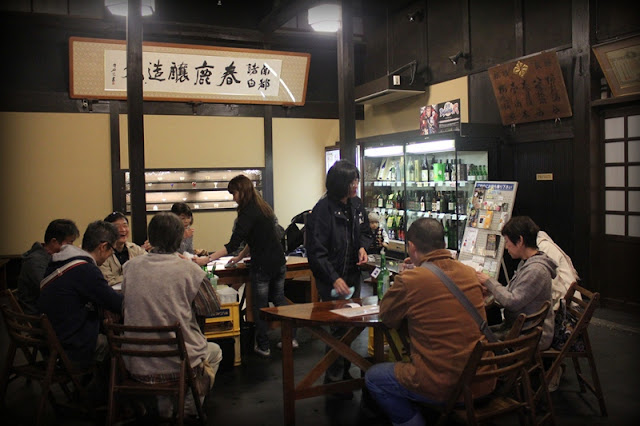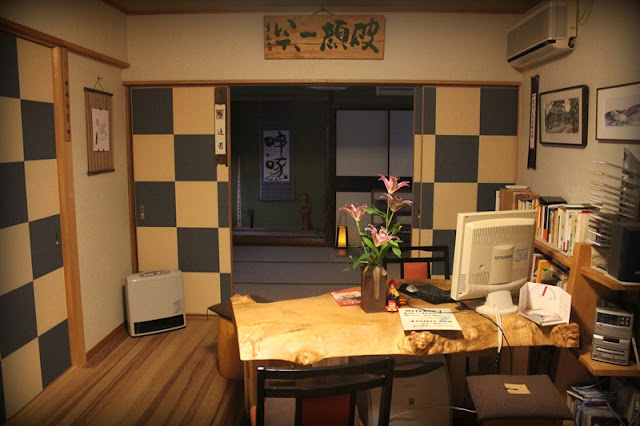From Osaka Namba to Nara is less than an hour train journey but the complexity of Japan train system confused us and we are late to meet our guide.
Ryokan Matsumae
We are suppose to meet our good will guide here.
Lake in between our ryokan and Kofukuji temple
Little guys sun tanning.
Kofukuji used to be the family temple of the Fujiwara, the most powerful family clan during much of the Nara and Heian Periods. The temple was established in Nara at the same time as the capital in 710. At the height of Fujiwara power, the temple consisted of over 150 buildings.
Today a couple of buildings of great historic value remain, including a five story pagoda and a three story pagoda.
Japanese god 神道 Shintō is not Japanese Buddhism. Like Chinese Buddhism there is statue in Japanese Buddha and the studies is passed down from India. Where-else in Shinto god, exist spiritually in any form any place anywhere.
Report card to prove that you are once here
At 50 meters, the five story pagoda is Japan's second tallest, just seven meters shorter than the five story pagoda at Kyoto's Toji Temple. Kofukuji's pagoda is both a landmark and symbol of Nara. It was first built in 730, and was most recently rebuilt in 1426.
Walking toward Todaiji
I am waiting....
Our guide Miyake san asked Inho to hold the biscuit high up above his head, the male deer are aggressive.
Inho says stop biting me!
Nandaimon Gate, a large wooden gate watched over by two fierce looking statues. Representing the Nio Guardian Kings, the statues are designated national treasures together with the gate itself.
The gate guardian are magnificent especially after Miyake san told us that there inst any nail involved in the construction, these two wooden guardians are stacked up using the same concept as Uno Stacko. How amazing, they have these kind of wisdom thousand of years ago.
Todaiji (東大寺, Tōdaiji, "Great Eastern Temple") is one of Japan's most famous and historically significant temples and a landmark of Nara. The temple was constructed in 752 as the head temple of all provincial Buddhist temples of Japan and grew so powerful that the capital was moved from Nara to Nagaoka in 784 in order to lower the temple's influence on government affairs. Todaiji's main hall, the Daibutsuden (Big Buddha Hall) is the world's largest wooden building, despite the fact that the present reconstruction of 1692 is only two thirds of the original temple hall's size. The massive building houses one of Japan's largest bronze statues of Buddha (Daibutsu). The 15 meters tall, seated Buddha represents Vairocana and is flanked by two Bodhisattvas.
Several smaller Buddhist statues and models of the former and current buildings are also on display in the Daibutsuden Hall. Another popular attraction is a pillar with a hole in its base that is the same size as the Daibutsu's nostril. It is said that those who can squeeze through this opening will be granted enlightenment in their next life.
Miyake san also told us many building within the temple compound are burned down by lighting and civil war many many times, only a few piece of item such as this lamp above are original and not rebuilt.
释迦牟尼佛
This look like our guan yin mah
Guardian
Model of original temple, much much bigger.
Rebuilt model after temple is burned down is much smaller due to insufficient funds.
Myth says if anyone can pass through this hole, the person will received abundant blessing.We only saw scary kids screaming and resisting to be pushed through by their parents.
My mimi eyes husband
Todaiji is really huge
Nigatsudo Hall where Omizutori is performed every March 1st to 14th
Second level of Nigatsudo hall, overview of Nara town.
Tea house where we can come here, sit and have a free cup of hot green tea.
For lunch, Miyake san brought us to this little corner restaurant near Todaiji temple.
Our 1000yen bento set looks oishii, everything so delicious.
Awww~ so adorable.
Kasuga Taisha is Nara's most celebrated shrine. It was established at the same time as the capital and is dedicated to the deity responsible for the protection of the city. Kasuga Taisha was also the tutelary shrine of the Fujiwara, Japan's most powerful family clan during most of the Nara and Heian Periods.
Kasuga Taisha is famous for its lanterns, which have been donated by worshipers. Hundreds of bronze lanterns can be found hanging from the buildings, while as many stone lanterns line its approaches. The lanterns are lit twice a year on the occasion of the Lantern Festivals in early February and mid August.
Dangling flowers that grew so long, sometime they touches the ground.
Naramachi (literally "Nara Town") is the former merchant district of Nara, where several traditional residential buildings and warehouses have been preserved. Boutiques, shops, cafes, restaurants and a few museums now line the district's narrow lanes. The machiya's front was kept narrow in order to save on taxes, which used to be calculated on a property's street access rather than its total area.
Scapegoat monkey, hang on your door, they will help you carry the bad luck.
Japanese mask in naramachi museum
Huge plate rich merchant use to serve food in Edo times.
Another museum, house museum, house from the Edo times.
Harushika, last destination Miyake san brought us, shochu 燒酒 master for the loyalty during Edo times.
Tasting session, 400yen to sample 5+1 kind of wine.
All the shocho we tried
Shocho cups for us to bring home as souvenirs, so thoughtful.
With our friendly good will guide, Miyake san.
Back to Ryokan Matsumae
Our humble little room
中谷堂, mochi master in Nara.
Cho mochi mochi
Went back the garden to play with the deer
Bambi, baby deer.
Female or baby deer are less aggressive and cuter.
The only shopping district in Nara
Dinner at Tonkatsu Ganko, tokatsu since 1963.
Very happy husband, having his favorite tonkatsu for dinner.
Ultimate tonkatsu platter for two.
Back in Ryokan Matsumae
Us, trying to act Japanese.
Cup of hot tea before bed time.
Snacks from Nara town.
Disclaimer: Partial captions (location history) are credited to JapanGuide.com, this trip is heavily planned using JapanGuide.com, captions are for my reference to pictures i took.
Disclaimer: Partial captions (location history) are credited to JapanGuide.com, this trip is heavily planned using JapanGuide.com, captions are for my reference to pictures i took.





















































































































No comments:
Post a Comment